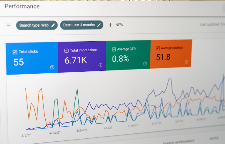
- March 24, 2023
- IT WIFI
- 0
Google Core Web Vitals Update: Understand How It Will Impact Your Website‘s Ranking
Google Core Web Vitals Update – Welcome to my blog post about the upcoming 2023 Google Core Vitals update. As a website owner or developer, you may be wondering how this update will affect your website’s search engine ranking. Furthermore, considering what steps you need to take to ensure that your website is optimized for the new metrics. In this blog post, I will share my insights on the Core Web Vitals update. Furthermore, we and provide tips on how you can prepare for this important change in website ranking. Let’s dive in!
What are the Core Vitals?
Core Web Vitals are a set of metrics that Google uses to measure the user experience on a website. So, there are three main metrics that are part of the Core Web Vitals:
Loading speed:
How quickly a page loads and becomes interactive for the user.
Interactivity:
The speed and how quickly the page responds to user interactions.
Visual stability:
Check how stable the content on the page is while it loads.
These metrics are important because they directly impact how users experience a website. So, if a website takes too long to load or is not responsive, users are more likely to leave the site and look for something else.
What is the Core Web Vitals update?
Google has announced that starting in 2023, the Core Web Vitals will be used as a ranking factor for websites. So, this means that websites that perform well on the Core Vitals metrics. Will be ranked higher on the search engine results page. This update is a significant change in how Google ranks websites and will have a big impact on website owners and developers.
Why is the update important?
The Core Web Vitals update is important because it will encourage website owners to focus on the user experience of their website. Websites that load quickly and respond quickly to user interactions will be ranked higher, which means they are more likely to be visited by users. This, in turn, will drive more traffic to those websites and potentially increase revenue.
As a consultant, I encourage website owners to start preparing for this update as soon as possible. Here are a few tips to help you get started:
Check your website’s current Core Web Vitals score.
You can use Google’s PageSpeed Insights tool to see how your website performs on the Core Web Vitals metrics. This will give you an idea of where your website stands and what areas you need to improve.
Optimize your website for speed.
One of the most important factors in the Core Vitals is loading speed. You can improve your website’s loading speed by optimizing images, using a content delivery network (CDN), and reducing the number of HTTP requests.
Improve interactivity.
To improve interactivity, you can reduce the number of third-party scripts on your website and prioritize the loading of critical resources.
Make sure your website is mobile-friendly.
With more and more users accessing the internet on mobile devices, it’s essential to ensure that your website is optimized for mobile devices. This includes using a responsive design and optimizing images and other content for mobile devices.
Playing Devil’s advocate, it’s important to note that some website owners may not see the Core Web Vitals update as a positive change. The update could potentially penalize websites that are not able to invest in optimizing their website for the new metrics. However, I believe that this update is a step in the right direction and will ultimately lead to a better user experience on the internet.
In conclusion, the Google Core Web Vitals update is an important change that will impact how websites are ranked on the search engine results page. As a website owner, it’s important to start preparing for this update as soon as possible to ensure that your website is optimized for the new metrics. By focusing on the user experience of your website
